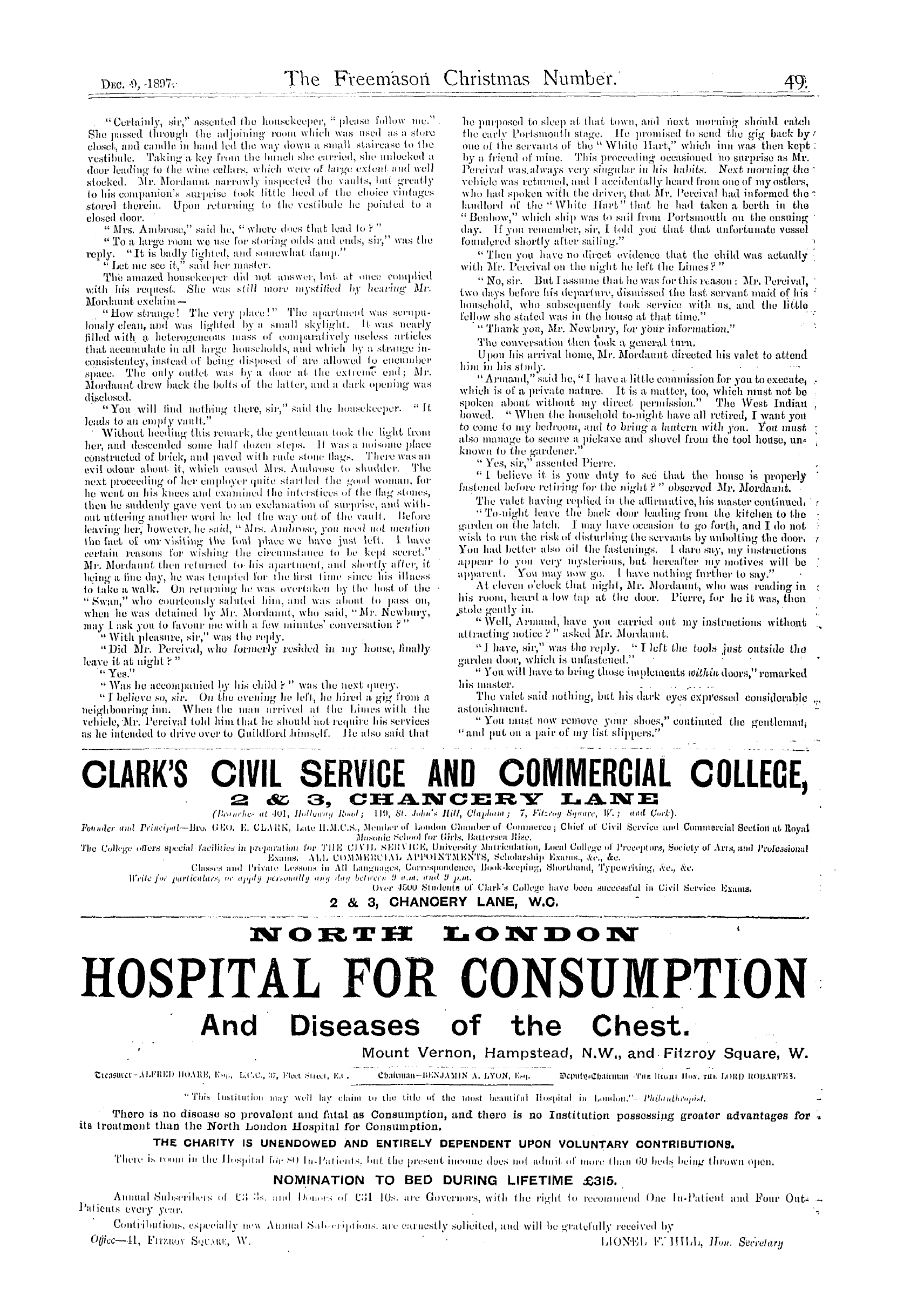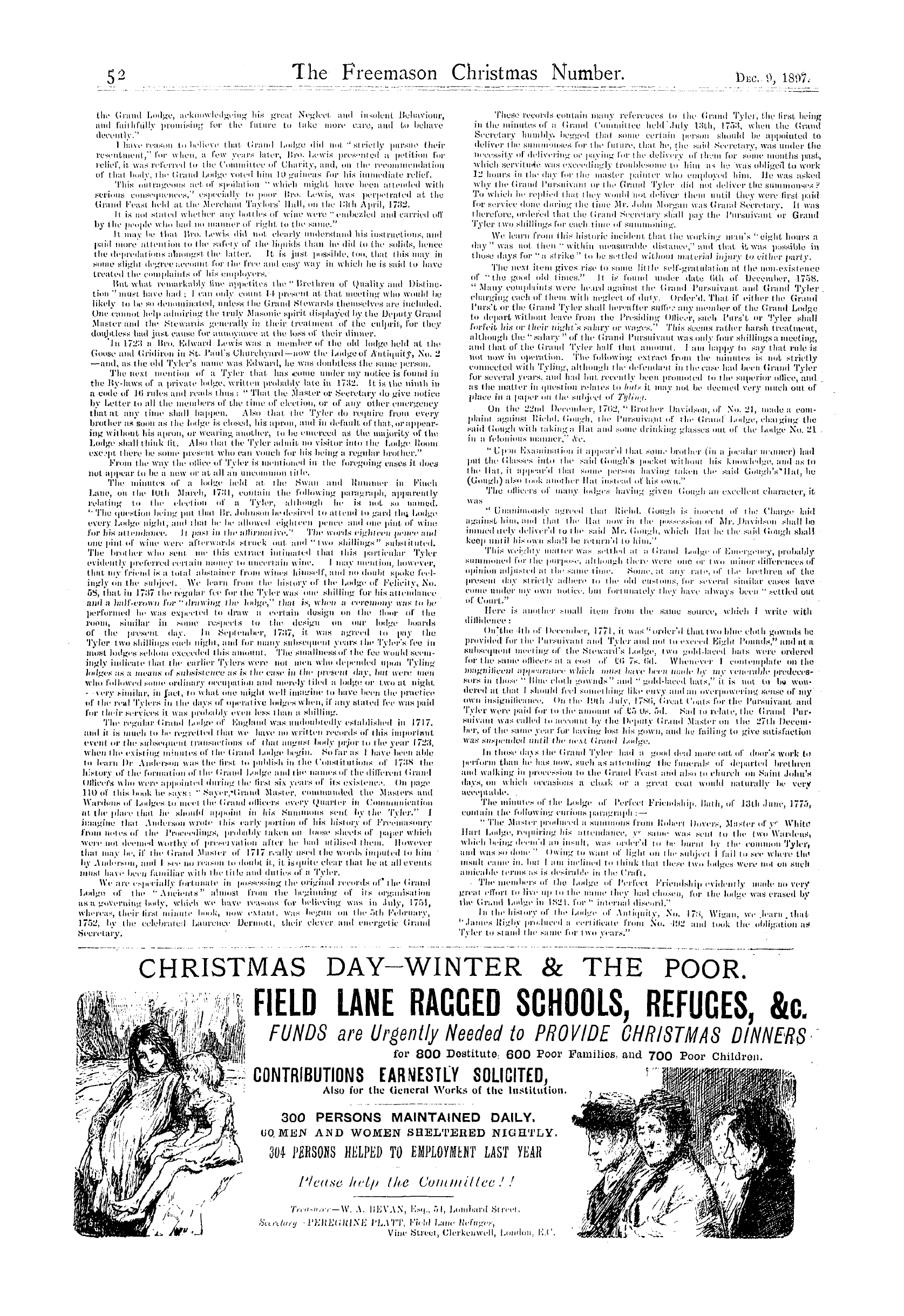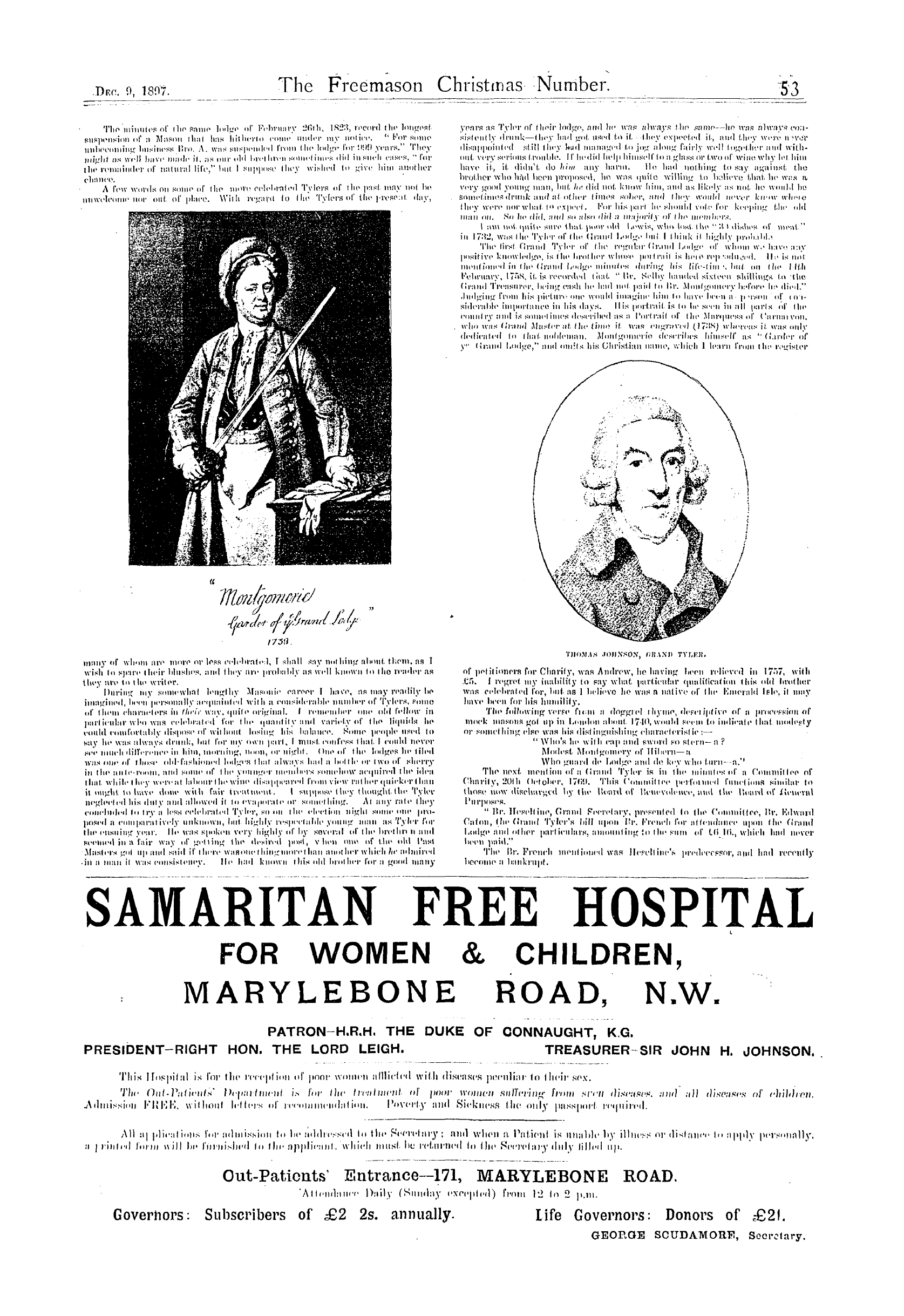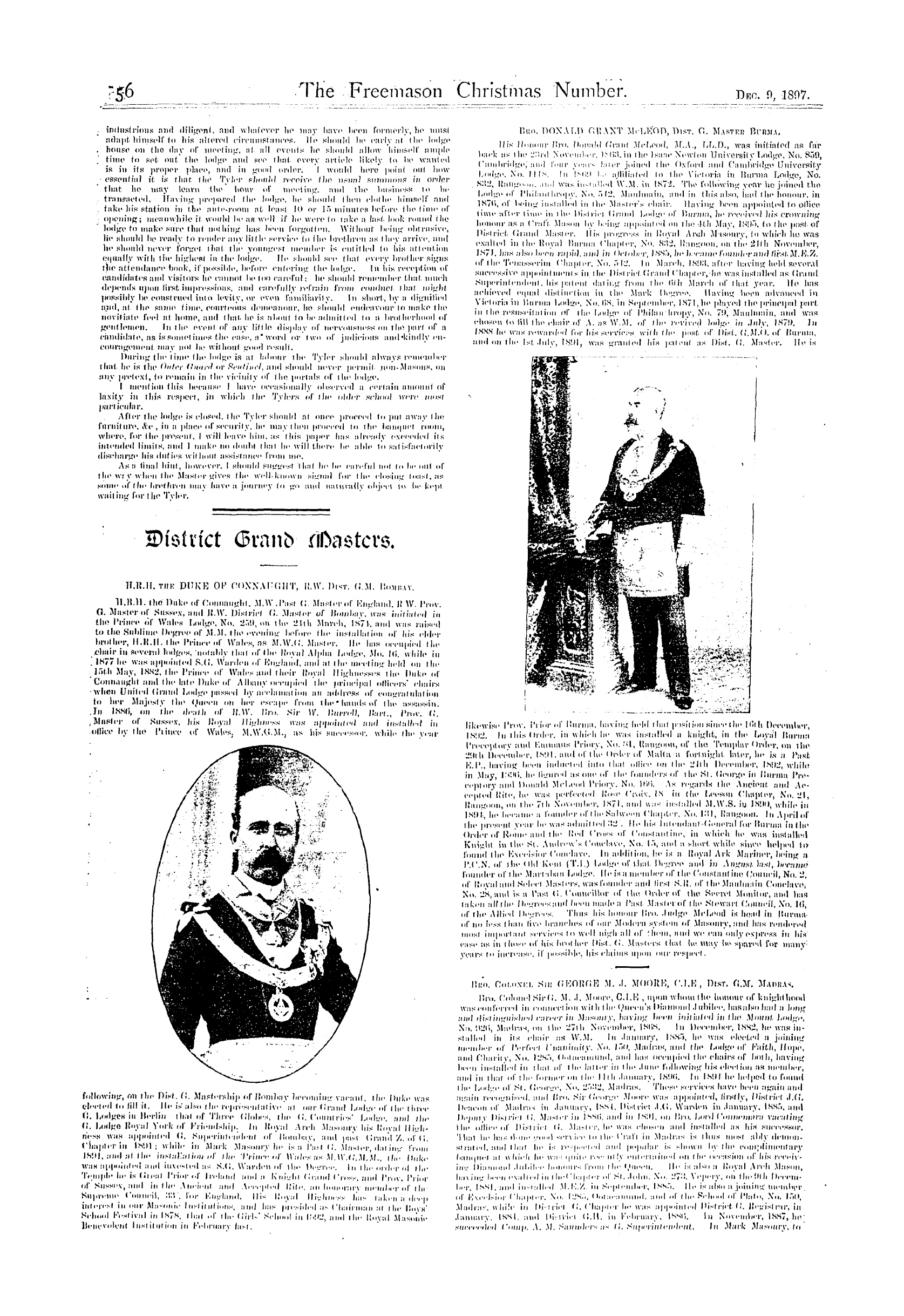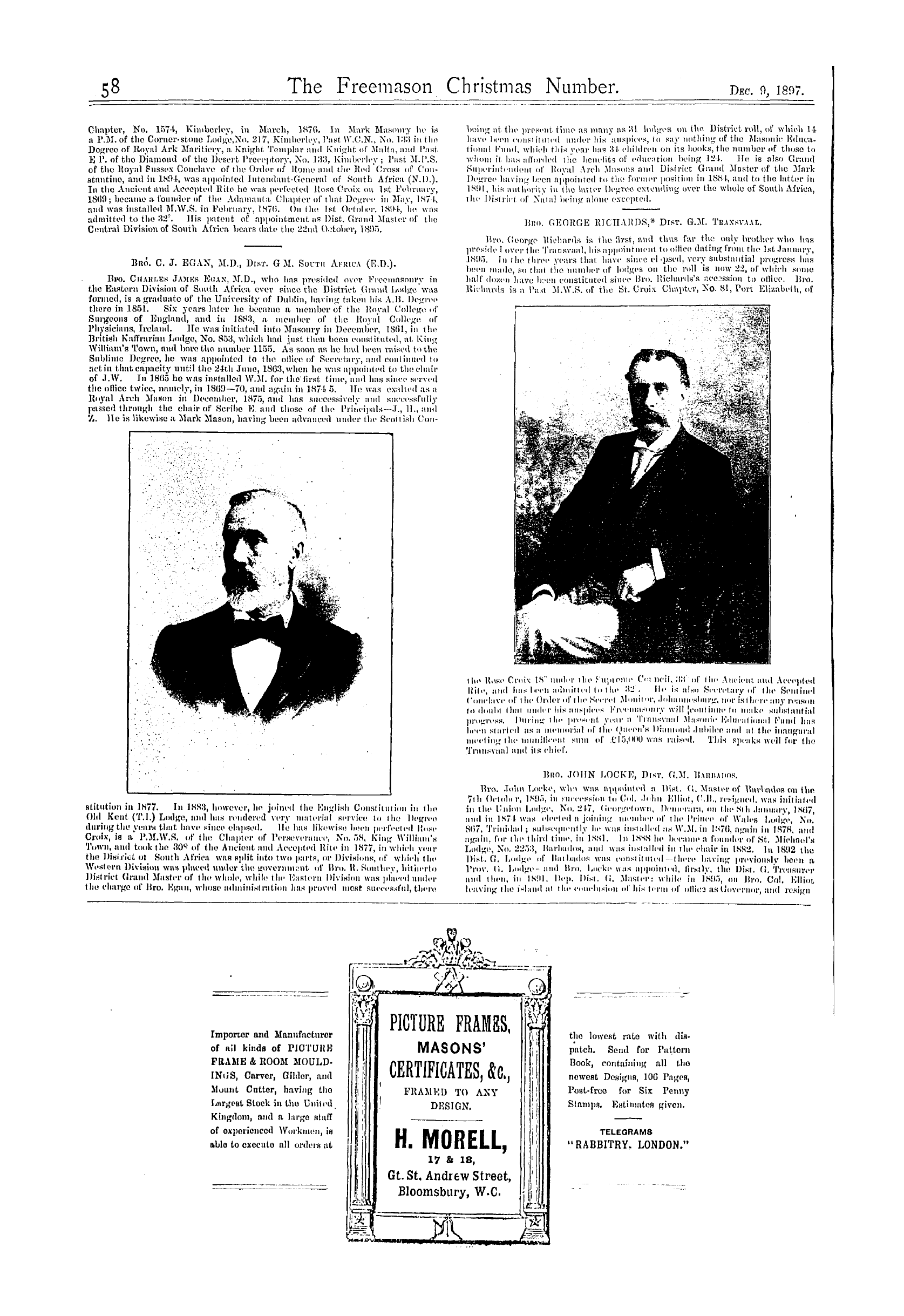-
Articles/Ads
Article Quatuor Coronati Lodge, No. 2076. ← Page 2 of 5 →
Note: This text has been automatically extracted via Optical Character Recognition (OCR) software.
Quatuor Coronati Lodge, No. 2076.
to light , and , looking back now upon the u years during which thc work has been prosecuted , we can fully realise how their hig hest expectations have not only been fulfilled but largely exceeded . Every year has seen many original papers of great value published and distributed to the Craft , and it is the
interest evoked by these which has increased so largely , and which , if maintained , will continue to augment that long roll of subscribers to our Transactions ; but to do this fresh ground must be ojjencd up almost yearly , and it is in this direction , I think , that each Master , as he is placed in the chair should not
only in his Address , but throughout his year of office , endeavour to help forward our work . The high qualification we require of all those who aspire to join the Inner Circle , warrants that each integral part of the Lodge proper ( numbering at present 31 ' brethren ) is strongly attached to some particular line of thought
interesting to Masonic Students , and it is natural to expect that thc new VV . M . should in his opening address urge the interest of those particular , wc might almost say personal , subjects of
research upon which his qualifications and subsequent admission to the Lodge were based . Such a course would obviate any chance of our Transactions settling down into particular grooves and thus becominer too technical for our varied readers .
For more than a year there has been standing m my name a promise to give a paper on "Wisdom , Strength , and Beauty , a Physical and Psychological examination of Masonic Symbolism . " The subject was a new one and it was not long before I found that tbe promise had been too rashly given—it was altogether
too vast a subject to be treated for presentation as a whole in thc restricted time allowed for reading at our Meetings . I ventured , therefore , to split it up and laid before you lately the lirst instalment of thc physical or operative side of the subject in a paper called " The Great Symbol . " In this I was only able
lo touch on certain operative aspects of Symbolism , but I indicated other lines which were to be kept for future consideration . Meanwhile , I think this a suitable opportunity to give you a glimpse of the sj ) cculative side of my subject , which will serve not only as an introduction to my year of ollice , but will , 1
trust , OJJCII up in your minds certain channels of thought by which may be obtained a grander and truer appreciation of the significance of the title T . G . A . O . T . U . Thc present occasion is more of a Festival than a day of laliour , and I propose , therefore , to treat my subject rather in the form ol a scientific romance
than as one of our regular papers . The time at my disposal is , however , short , and I am obliged to confine my remarks to the subjects of Wisdom and Strength representing Omniscience and Omnipresence . Kindly , therefore , place the speculative side of your nature at my disposal , and we will attempt to understand
some of those "Hidden Mysteries of Nature and Science " which it is the duty of every Mason to study . We shall find at the outset that it is only when we have fully appreciated what Light really is and are able to make that wonderful messenger subservient to our will that we can hope to fathom thc depth of
these mysteries ., The Lodge , we know , symbolises the Universe and its dimensions are within the scope of our understanding ; can we in turn grasp thc mighty design laid out on the Tracing Board of thc great Architect , thc scale on which thc Universe has been built ? Let us try .
Wc must first throw aside , all preconceived ideas of magnitude and ajqiroach the subject with that true humility which is forced to exclaim He who knows most , knows mod how little he knows . On the very threshold of our investigation sits , as in the mystical initiation of the Rosicrucians , a great , unfathomable ,
awe-inspiring phantom , the terror of which must be borne without flinching if we are to pass forward to higher thoughts . I speak of the Infinities of Time and Space , the "for-cver" and the " never-ending , " and in order to elucidate thc subject I have chosen , I shall now examine these two mysteries as far as the
present stale of science will allow us . I shall first take the subject of space , and I think the best method I can adopt will be to take you , in imagination , for a journey as far as is possible by means of the best instruments now in use . We will start from the Sun , and moving outwards we will rajiidly mark thc
number and character of tbe worlds involved in the solar system . Let us lirst understand what arc thc dimensions of our central Luminary . Tbe distance of the Moon from thc earth is 240 , 000 miles , but the dimensions of the Sun arc so great that , were thc centre of thc Sun placed where the centre of thc earth
is , the surface of the Sun would not only extend as far as thc Moon but as far again on thc other side and that would give the radius only of the enormous circumference of the Sun . Let us now start outward- from this vast mass . Thc first world wc
meet is the planet Mercury , revolving round the Sun at a distance of 3 ( 1 , 000 , 000 miles . This little world is only 3000 miles in diameter , and completes its year in 88 of our days . Owing to the difficulty of observation verv little is known as to its
character . Wc next come upon Venus , at a distance of 67 , 000 , 000 miles . She is only 400 miles smaller in diameter than our earth ; her year is 225 of our days , and with the dense atmosphere with which she is surrounded , animal and vegetable life similar to that on our globe would be possible . Continuing
our course , we arrive at the earth , situated 93 , , 000 miles away from the Sun . Still speeding on , a further 50 , 000 , 000 miles brings us to Mars , with a diameter of nearly 5000 miles , and a year of 6 S 7 of our days . The conditions on this little globe are more like those of the earth than on any other planet .
and its day is almost the same length , namely 24 hours , 39 minutes . The sight of this planet in a good instrument is most interesting . Oceans and Continents are plainly visible , and the telescope shows large tracks of ice surrounding its polar regions , which increase considerably during the winter , and
decrease during tbe summer seasons on that planet . It was only in 1 S 77 lhat it was discovered that Mars was attended by two moons , one of which is only seven miles , and tbe other six miles in diameter . Thc distances wc now have to travel
become so great that I shall not attempt to give them . You can , however , form an idea of tbe tremendous spaces we are traversing when you consider that each successive planet is nearl y double as lar from tbe Sun as the preceding one .
We next arrive at a group of small planets entirely different from anything else we have seen . In the last century * , before any of these little worlds were known , an astronomer , Professor Bode , had discovered a law which seemed to regulate the
distances of the planets from Ihe Sun , except in one place where , according to the law , a large world should have been ; but , in spite of careful observation , none was to be found . As early as 1784 astronomers began to compute the orbit and period of this mysterious world , and for 16 years every year was
ex-STAN-MllHK OIlSI-aiVATORY : INSlIIR VIEW . pected lo add a new world to the system ; but the discovery was still delayed until the year 1800 , when these scientific men finally resolved that this mysterious but invisible world should be made the subject of a thorough search . They therefore each took a
part of the heavens to watch night after night , and at last they were successful ; but instead of finding one j'lanet , they found eight small bodies revolving in the same orbit in which they expected to find a large world , and , strange to say , once in each of their periods of revolution they passed through very nearly
the same j > oint . The idea immediately forced itself on the mind that these must be fragments of a large world disintegrated by some terrific catastrophe . We can hardly realise what a fearful explosive force must have been let loose to produce such a tremendous result . This point of intersection has been the focus
of many of the largest telescopes from that tunc , until at the present day there have been found over 300 of these fragments whirling through space . These little worlds range in size from about 200 miles in diameter , down to only a few hundred yards . Let us now continue our voyage over thc next huge space
and arrive at Jupiter , thc largest and most magnificent of the planets . This world is more than 1000 times larger than our earth , its circumference being actually greater than the distance of the Moon from the Earth . It has \\\ c moons , and its year is about 12 limes as long as ours . Pursuing our journey , wc
next come lo Solum ; ll is nearly as large as Jupiter , and has a huge ring ol" planetary matter revolving round it in addition to seven moons . Further and further wc go and the planets behind us are disappearing , and even the sun is dwindling down to a mere speck ; slill we hurry on , and at last alight on another planet , Uranus , about 60 times larger than our earth . We see
Note: This text has been automatically extracted via Optical Character Recognition (OCR) software.
Quatuor Coronati Lodge, No. 2076.
to light , and , looking back now upon the u years during which thc work has been prosecuted , we can fully realise how their hig hest expectations have not only been fulfilled but largely exceeded . Every year has seen many original papers of great value published and distributed to the Craft , and it is the
interest evoked by these which has increased so largely , and which , if maintained , will continue to augment that long roll of subscribers to our Transactions ; but to do this fresh ground must be ojjencd up almost yearly , and it is in this direction , I think , that each Master , as he is placed in the chair should not
only in his Address , but throughout his year of office , endeavour to help forward our work . The high qualification we require of all those who aspire to join the Inner Circle , warrants that each integral part of the Lodge proper ( numbering at present 31 ' brethren ) is strongly attached to some particular line of thought
interesting to Masonic Students , and it is natural to expect that thc new VV . M . should in his opening address urge the interest of those particular , wc might almost say personal , subjects of
research upon which his qualifications and subsequent admission to the Lodge were based . Such a course would obviate any chance of our Transactions settling down into particular grooves and thus becominer too technical for our varied readers .
For more than a year there has been standing m my name a promise to give a paper on "Wisdom , Strength , and Beauty , a Physical and Psychological examination of Masonic Symbolism . " The subject was a new one and it was not long before I found that tbe promise had been too rashly given—it was altogether
too vast a subject to be treated for presentation as a whole in thc restricted time allowed for reading at our Meetings . I ventured , therefore , to split it up and laid before you lately the lirst instalment of thc physical or operative side of the subject in a paper called " The Great Symbol . " In this I was only able
lo touch on certain operative aspects of Symbolism , but I indicated other lines which were to be kept for future consideration . Meanwhile , I think this a suitable opportunity to give you a glimpse of the sj ) cculative side of my subject , which will serve not only as an introduction to my year of ollice , but will , 1
trust , OJJCII up in your minds certain channels of thought by which may be obtained a grander and truer appreciation of the significance of the title T . G . A . O . T . U . Thc present occasion is more of a Festival than a day of laliour , and I propose , therefore , to treat my subject rather in the form ol a scientific romance
than as one of our regular papers . The time at my disposal is , however , short , and I am obliged to confine my remarks to the subjects of Wisdom and Strength representing Omniscience and Omnipresence . Kindly , therefore , place the speculative side of your nature at my disposal , and we will attempt to understand
some of those "Hidden Mysteries of Nature and Science " which it is the duty of every Mason to study . We shall find at the outset that it is only when we have fully appreciated what Light really is and are able to make that wonderful messenger subservient to our will that we can hope to fathom thc depth of
these mysteries ., The Lodge , we know , symbolises the Universe and its dimensions are within the scope of our understanding ; can we in turn grasp thc mighty design laid out on the Tracing Board of thc great Architect , thc scale on which thc Universe has been built ? Let us try .
Wc must first throw aside , all preconceived ideas of magnitude and ajqiroach the subject with that true humility which is forced to exclaim He who knows most , knows mod how little he knows . On the very threshold of our investigation sits , as in the mystical initiation of the Rosicrucians , a great , unfathomable ,
awe-inspiring phantom , the terror of which must be borne without flinching if we are to pass forward to higher thoughts . I speak of the Infinities of Time and Space , the "for-cver" and the " never-ending , " and in order to elucidate thc subject I have chosen , I shall now examine these two mysteries as far as the
present stale of science will allow us . I shall first take the subject of space , and I think the best method I can adopt will be to take you , in imagination , for a journey as far as is possible by means of the best instruments now in use . We will start from the Sun , and moving outwards we will rajiidly mark thc
number and character of tbe worlds involved in the solar system . Let us lirst understand what arc thc dimensions of our central Luminary . Tbe distance of the Moon from thc earth is 240 , 000 miles , but the dimensions of the Sun arc so great that , were thc centre of thc Sun placed where the centre of thc earth
is , the surface of the Sun would not only extend as far as thc Moon but as far again on thc other side and that would give the radius only of the enormous circumference of the Sun . Let us now start outward- from this vast mass . Thc first world wc
meet is the planet Mercury , revolving round the Sun at a distance of 3 ( 1 , 000 , 000 miles . This little world is only 3000 miles in diameter , and completes its year in 88 of our days . Owing to the difficulty of observation verv little is known as to its
character . Wc next come upon Venus , at a distance of 67 , 000 , 000 miles . She is only 400 miles smaller in diameter than our earth ; her year is 225 of our days , and with the dense atmosphere with which she is surrounded , animal and vegetable life similar to that on our globe would be possible . Continuing
our course , we arrive at the earth , situated 93 , , 000 miles away from the Sun . Still speeding on , a further 50 , 000 , 000 miles brings us to Mars , with a diameter of nearly 5000 miles , and a year of 6 S 7 of our days . The conditions on this little globe are more like those of the earth than on any other planet .
and its day is almost the same length , namely 24 hours , 39 minutes . The sight of this planet in a good instrument is most interesting . Oceans and Continents are plainly visible , and the telescope shows large tracks of ice surrounding its polar regions , which increase considerably during the winter , and
decrease during tbe summer seasons on that planet . It was only in 1 S 77 lhat it was discovered that Mars was attended by two moons , one of which is only seven miles , and tbe other six miles in diameter . Thc distances wc now have to travel
become so great that I shall not attempt to give them . You can , however , form an idea of tbe tremendous spaces we are traversing when you consider that each successive planet is nearl y double as lar from tbe Sun as the preceding one .
We next arrive at a group of small planets entirely different from anything else we have seen . In the last century * , before any of these little worlds were known , an astronomer , Professor Bode , had discovered a law which seemed to regulate the
distances of the planets from Ihe Sun , except in one place where , according to the law , a large world should have been ; but , in spite of careful observation , none was to be found . As early as 1784 astronomers began to compute the orbit and period of this mysterious world , and for 16 years every year was
ex-STAN-MllHK OIlSI-aiVATORY : INSlIIR VIEW . pected lo add a new world to the system ; but the discovery was still delayed until the year 1800 , when these scientific men finally resolved that this mysterious but invisible world should be made the subject of a thorough search . They therefore each took a
part of the heavens to watch night after night , and at last they were successful ; but instead of finding one j'lanet , they found eight small bodies revolving in the same orbit in which they expected to find a large world , and , strange to say , once in each of their periods of revolution they passed through very nearly
the same j > oint . The idea immediately forced itself on the mind that these must be fragments of a large world disintegrated by some terrific catastrophe . We can hardly realise what a fearful explosive force must have been let loose to produce such a tremendous result . This point of intersection has been the focus
of many of the largest telescopes from that tunc , until at the present day there have been found over 300 of these fragments whirling through space . These little worlds range in size from about 200 miles in diameter , down to only a few hundred yards . Let us now continue our voyage over thc next huge space
and arrive at Jupiter , thc largest and most magnificent of the planets . This world is more than 1000 times larger than our earth , its circumference being actually greater than the distance of the Moon from the Earth . It has \\\ c moons , and its year is about 12 limes as long as ours . Pursuing our journey , wc
next come lo Solum ; ll is nearly as large as Jupiter , and has a huge ring ol" planetary matter revolving round it in addition to seven moons . Further and further wc go and the planets behind us are disappearing , and even the sun is dwindling down to a mere speck ; slill we hurry on , and at last alight on another planet , Uranus , about 60 times larger than our earth . We see















































